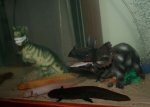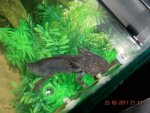oroxine
New member
- Joined
- Aug 23, 2011
- Messages
- 77
- Reaction score
- 0
- Points
- 0
- Location
- The Shire (Sydney)
- Country
- Australia
- Display Name
- Caity :)
So I recently bought a black axolotl, he was fully black, with some slight discoloration through him. However recently these spots have become much more prominent and lighter. Is this just a sign of maturing or something worse?
I have attached pictures, any idea would be great!! The one where he is with my other two axolotls was taken about two weeks ago and the one where he is by himself was taken yesterday
I have attached pictures, any idea would be great!! The one where he is with my other two axolotls was taken about two weeks ago and the one where he is by himself was taken yesterday


